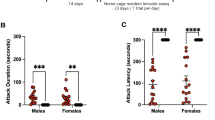Abstract
In the present study we compared genetically selected aggressive (TA) and nonaggressive (TNA) male mice, as well as males from an unselected control line (SW), in three tests of anxiety: the elevated plus-maze, the light-dark box, and the staircase test. Males were tested repeatedly for 3 days. In all three tests TA males were found to be more active and less anxious than TNA males, with SW males showing more or less intermediate scores. Furthermore, repeated plus-maze testing induced anxiety-like behavior in both TA and TNA mice, whereas repeated testing in the light-dark and staircase paradigms resulted in different responses. Whereas TNA animals were found to be stable, TA animals showed habituation on the second and third day of testing. The obtained data support the conclusion that a higher-level offensive aggression entails lower level of anxiety.
Similar content being viewed by others
References
Benus, R. F., Bohus, B., Koolhaas, J. M., and van Oortmerssen, G. A. (1991). Heritable variation for aggression as a reflection of individual coping strategies. Experientia 47:1008-1019.
Clement, Y., and Chapouthier, G. (1998). Biological bases of anxiety. Neurosci. Biobehav. Rev. 22:623-633.
Costall, B., Jones, B. J., Kelly, M. E., Naylor, R. J., and Tomkins, D. M. (1989). Exploration of mice in a black and white test box: Validation as a model of anxiety. Pharmacol. Biochem. Behav. 32:777-785.
Crawley, J., and Goodwin, F. K. (1980). Preliminary report of a simple animal behavior model for the anxiolytic effects of benzodiazepines. Pharmacol. Biochem. Behav. 13:167-170.
de Boer, S. F., van der Vegt, B. J., and Koolhaas, J. M. (2003). Individual variation in aggression of feral rodent strains: A standard for the genetics of aggression and violence? Behav. Genet. (this issue). Author please supply missing information
Espejo, E. F. (1997). Effects of weekly or daily exposure to the elevated plus-maze in male mice. Behav. Brain. Res. 87:233-238.
Ferrari, P. F., Palanza, P., Parmigiani, S., and Rodgers, R. J. (1998). Interindividual variability in Swiss male mice: Relationship between social factors, aggression, and anxiety. Physiol. Behav. 63:821-827.
File, S. E. (1990). One-trial tolerance to the anxiolytic effects of chlordiazepoxide in the plus-maze. Psychopharmacology (Berl.) 100:281-282.
Guillot, P. V., and Chapouthier, G. (1996). Intermale aggression and dark/light preference in ten inbred mouse strains. Behav. Brain. Res. 77:211-213.
Hascoet, M., Bourin, M., and Nic Dhonnchadha, B. A. (2000). The influence of buspirone, and its metabolite 1-PP, on the activity of paroxetine in the mouse light/dark paradigm and four plates test. Pharmacol. Biochem. Behav. 67:45-53.
Hogg, S., Hof, M., Wurbel, H., Steimer, T., de Ruiter, A., Koolhaas, J., and Sluyter, F. (2000). Behavioral profiles of genetically selected aggressive and nonaggressive male wild house mice in two anxiety tests. Behav. Genet. 30:439-446.
Holmes, A., Iles, J. P., Mayell, S. J., and Rodgers, R. J. (2001). Prior test experience compromises the anxiolytic efficacy of chlordiazepoxide in the mouse light/dark exploration test. Behav. Brain. Res. 122:159-167.
Lagerspetz, K. M. J. (1964). Studies on the aggressive behaviour of mice. Ann. Acad. Sci. Fenn. B 133 pp. Author please supply missing information.
Lagerspetz, K. M., and Lagerspetz, K. Y. (1971). Changes in the aggressiveness of mice resulting from selective breeding, learning and social isolation. Scand. J. Psychol. 12:241-248.
Miczek, K. A. (1974). Intraspecies aggression in rats: Effects of D-amphetamine and chlordiazepoxide. Psychopharmacologia 39:275-301.
Miczek, K. A., and O'Donnell, J. M. (1980). Alcohol and chlordiazepoxide increase suppressed aggression in mice. Psychopharmacology (Berl.) 69:39-44.
Miczek, K. A., Weerts, E. M., Vivian, J. A., and Barros, H. M. (1995). Aggression, anxiety and vocalizations in animals: GABAA and 5-HT anxiolytics. Psychopharmacology (Berl.) 121:38-56.
Mos, J., Olivier, B., and van der Poel, A. M. (1987). Modulatory actions of benzodiazepine receptor ligands on agonistic behaviour. Physiol. Behav. 41:265-278.
Palanza, P., Rodgers, R. J., Ferrari, P. F., and Parmigiani, S. (1996). Effects of chlordiazepoxide on maternal aggression in mice depend on experience of resident and sex of intruder. Pharmacol. Biochem. Behav. 54:175-182.
Podhorna, J., and Krsiak, M. (2000). Behavioural effects of a benzodiazepine receptor partial agonist, Ro 19-8022, in the social conflict test in mice. Behav. Pharmacol. 11:143-151.
Poshivalov, V. P., Suchotina, I. A., and Verbitzkaya, E. V. (1988). Ethological pharmacology of anxiogenic and anxiolytic drugs. Ann. Ist Super. Sanita. 24:453-459.
Rodgers, R. J., Cao, B. J., Dalvi, A., and Holmes, A. (1997). Animal models of anxiety: An ethological perspective. Braz. J. Med. Biol. Res. 30:289-304.
Sandnabba, N. K. (1996). Selective breeding for isolation-induced intermale aggression in mice: Associated responses and environmental influences. Behav. Genet. 26:477-488.
Sandnabba, N. K. (1997). Territorial behaviour and social organization as a function of the level of aggressiveness in male mice. Ethology 103:566-577.
Simiand, J., Keane, P. E., and Morre, M. (1984). The staircase test in mice: A simple and efficient procedure for primary screening for anxiolytic agents. Psychopharmacology 84:48-53.
Teskey, G. C., and Kavaliers, M. (1987). Aggression, defeat and opioid activation in mice: Influences of social factors, size and territory. Behav. Brain Res. 23:77-84.
Treit, D., Menard, J., and Royan, C. (1993). Anxiogenic stimuli in the elevated plus-maze. Pharmacol. Biochem. Behav. 44:463-469.
van Oortmerssen, G. A., and Bakker, T. C. (1981). Artificial selection for short and long attack latencies in wild Mus musculus domesticus. Behav. Genet. 11:115-126.
Veenema, A. H., Meijer, O. C., de Kloet, E. R., Koolhaas, J. M., and Bohus, B. G. (2003). Differences in basal and stress-induced HPA regulation of wild house mice selected for high and low aggression. Horm. Behav. 43:197-204.
Weiss, S. M., Wadsworth, G., Fletcher, A., and Dourish, C. T. (1998). Utility of ethological analysis to overcome locomotor confounds in elevated maze models of anxiety. Neurosci. Biobehav. Rev. 23:265-271.
Rights and permissions
About this article
Cite this article
Nyberg, J.M., Vekovischeva, O. & Sandnabba, N.K. Anxiety Profiles of Mice Selectively Bred for Intermale Aggression. Behav Genet 33, 503–511 (2003). https://doi.org/10.1023/A:1025718531997
Issue Date:
DOI: https://doi.org/10.1023/A:1025718531997




